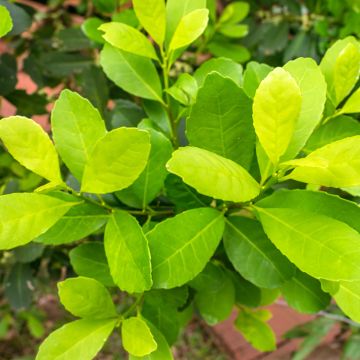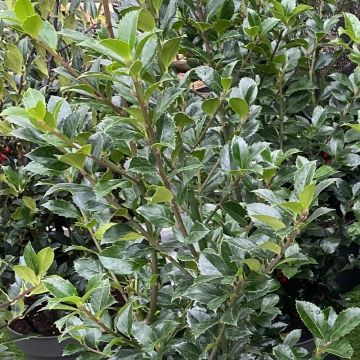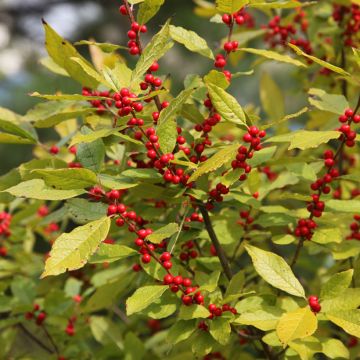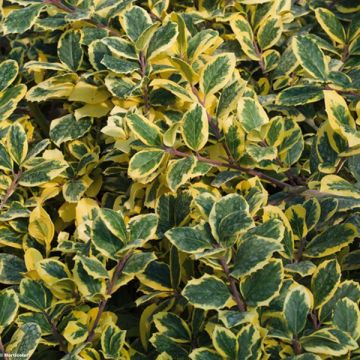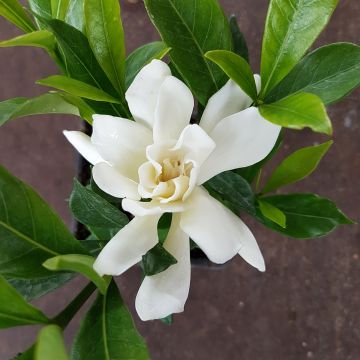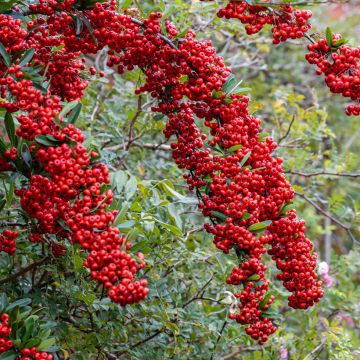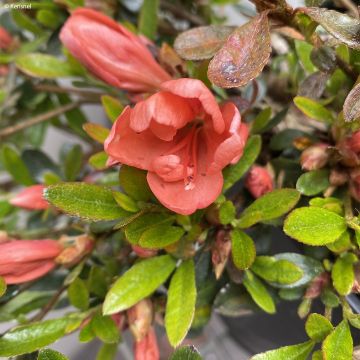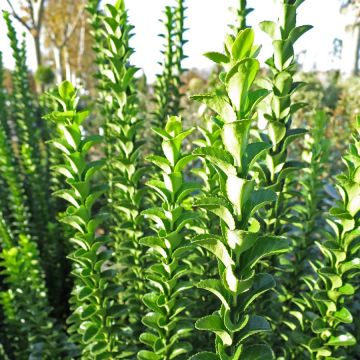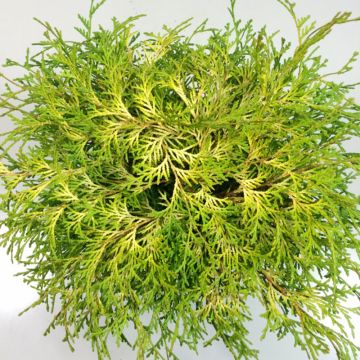

Ilex crenata Golden Gem - Japanese Holly
Ilex crenata Golden Gem - Japanese Holly
Ilex crenata Golden Gem
Japanese Holly, Box-leaved Holly, Box-leaved Ilex, Dwarf Holly
This item cannot be shipped to the selected country
Delivery charge from €5.90
Delivery to Corse prohibited
More information
Schedule delivery date,
and select date in basket
This plant carries a 24 months recovery warranty
More information
We guarantee the quality of our plants for a full growing cycle, and will replace at our expense any plant that fails to recover under normal climatic and planting conditions.
From €5.90 for pickup delivery and €6.90 for home delivery
Express home delivery from €8.90.
Delivery to Corse prohibited: UE law prohibits the import of this plant from mainland France to Corse as part of the fight against Xylella fastidiosa. Please accept our sincere apologies.
More information

Does this plant fit my garden?
Set up your Plantfit profile →
Description
The 'Golden Gem' Ilex crenata is a variety of Japanese Holly with an interesting compact and spreading habit, as well as bright foliage which is golden from October to March. This small shrub stands out in winter when other plants are dormant. This relation of the holly is a small evergreen shrub that tolerates pruning very well, and can be used to replace boxwood in landscaping. Its small size and natural elegance make it particularly suitable for small gardens and container gardens. The Japanese holly is easy to grow in loose soil, not too chalky but slightly acidic, in full sun or partial shade.
The Japanese holly, in Latin Ilex crenata, is a shrub native to Japan that belongs to the Aquifoliaceae family, just like the common holly. The 'Golden Gem' variety, as its name suggests, has been selected for its yellow leaves. It is a slow-growing shrub, especially during the establishment phase which lasts 2 to 3 years. This variety has a bushy, highly branched, low, wide, and dense habit. The branches tend to grow horizontally, giving the unpruned shrub a broad cushion-like silhouette. At maturity, when allowed to grow freely, it will reach an average height of 80 cm (31.5 in) to 1 m (3 ft 4 in) with a spread of 1 m (3 ft 4 in) to 1.50 m (4 ft 11 in). Its tiny leaves are 1 cm (0.4 in) long round and leathery. They are golden when they emerge and turn green in summer. They are slightly glossy and non-prickly. All hollies are dioecious plants, meaning there are male plants with male flowers and female plants with female flowers. Only the female plants produce berries. The Golden Gem Japanese holly is a female clone. It produces small inconspicuous flowers in May-June, but they are nectar-bearing and matte white in colour. After fertilisation by a male holly planted nearby, they will develop into fleshy, round berries that are shiny black and 6 mm (0.2 in) in diameter. The seeds are dispersed by birds that love the fruits.
With faster growth than boxwood, Ilex crenata Golden Gem will please gardeners who love contemporary style, French gardens, well-maintained hedges, and topiary. It is perfect in a container on the terrace or balcony. Undemanding, it dislikes excessive sunlight and limestone soils, and prefers well-drained, loose, deep, and fairly fertile soils. Hardy well beyond -15°C, it likes partially shaded to shaded areas, for example under trees or facing east. Planted alone, shaped into topiary, or trained as a small tree, it is particularly striking in winter. Plant in Zen gardens alongside dwarf bamboos, Japanese maples, camellias... Its association with Mexican orange trees and bushy honeysuckles (Lonicera Nitida, Lonicera pileata) is also interesting for creating the persistent structure of a border.
Report an error about the product description
Ilex crenata Golden Gem - Japanese Holly in pictures




Plant habit
Flowering
Foliage
Botanical data
Ilex
crenata
Golden Gem
Aquifoliaceae
Japanese Holly, Box-leaved Holly, Box-leaved Ilex, Dwarf Holly
Cultivar or hybrid
Other Ilex - Holly
Planting and care
To plant the Golden Gem holly, add a generous amount of potting soil with compost and incorporate it into the soil of your garden to slightly acidify and fertilize it. If your soil is rich in active limestone, the holly may tend to develop chlorosis (the foliage gradually turns yellow around the leaf veins) and struggle to thrive. Choose a sunny location, but not scorching, partially shaded (or shaded in hot climates). Follow the watering (with non-calcium or low calcium water) for the first 2-3 years, especially during summer and in case of prolonged drought, to help the bush establish itself. It will then manage on its own as it tolerates drought quite well, in partial shade and deep soil.
When you want to give a specific shape to this crenate holly, trim it once or twice a year: first in early summer, and possibly in September-October. Ilex can be attacked by holly leaf miners, white scale insects in spring, and mites and aphids in summer. Consider applying a preventive treatment at the beginning of the season. Ilex crenata prefers climates with cold winters and mild, not too hot summers.
Planting period
Intended location
Care
-
, onOrder confirmed
Reply from on Promesse de fleurs
Evergreen shrubs
Haven't found what you were looking for?
Hardiness is the lowest winter temperature a plant can endure without suffering serious damage or even dying. However, hardiness is affected by location (a sheltered area, such as a patio), protection (winter cover) and soil type (hardiness is improved by well-drained soil).

Photo Sharing Terms & Conditions
In order to encourage gardeners to interact and share their experiences, Promesse de fleurs offers various media enabling content to be uploaded onto its Site - in particular via the ‘Photo sharing’ module.
The User agrees to refrain from:
- Posting any content that is illegal, prejudicial, insulting, racist, inciteful to hatred, revisionist, contrary to public decency, that infringes on privacy or on the privacy rights of third parties, in particular the publicity rights of persons and goods, intellectual property rights, or the right to privacy.
- Submitting content on behalf of a third party;
- Impersonate the identity of a third party and/or publish any personal information about a third party;
In general, the User undertakes to refrain from any unethical behaviour.
All Content (in particular text, comments, files, images, photos, videos, creative works, etc.), which may be subject to property or intellectual property rights, image or other private rights, shall remain the property of the User, subject to the limited rights granted by the terms of the licence granted by Promesse de fleurs as stated below. Users are at liberty to publish or not to publish such Content on the Site, notably via the ‘Photo Sharing’ facility, and accept that this Content shall be made public and freely accessible, notably on the Internet.
Users further acknowledge, undertake to have ,and guarantee that they hold all necessary rights and permissions to publish such material on the Site, in particular with regard to the legislation in force pertaining to any privacy, property, intellectual property, image, or contractual rights, or rights of any other nature. By publishing such Content on the Site, Users acknowledge accepting full liability as publishers of the Content within the meaning of the law, and grant Promesse de fleurs, free of charge, an inclusive, worldwide licence for the said Content for the entire duration of its publication, including all reproduction, representation, up/downloading, displaying, performing, transmission, and storage rights.
Users also grant permission for their name to be linked to the Content and accept that this link may not always be made available.
By engaging in posting material, Users consent to their Content becoming automatically accessible on the Internet, in particular on other sites and/or blogs and/or web pages of the Promesse de fleurs site, including in particular social pages and the Promesse de fleurs catalogue.
Users may secure the removal of entrusted content free of charge by issuing a simple request via our contact form.
The flowering period indicated on our website applies to countries and regions located in USDA zone 8 (France, the United Kingdom, Ireland, the Netherlands, etc.)
It will vary according to where you live:
- In zones 9 to 10 (Italy, Spain, Greece, etc.), flowering will occur about 2 to 4 weeks earlier.
- In zones 6 to 7 (Germany, Poland, Slovenia, and lower mountainous regions), flowering will be delayed by 2 to 3 weeks.
- In zone 5 (Central Europe, Scandinavia), blooming will be delayed by 3 to 5 weeks.
In temperate climates, pruning of spring-flowering shrubs (forsythia, spireas, etc.) should be done just after flowering.
Pruning of summer-flowering shrubs (Indian Lilac, Perovskia, etc.) can be done in winter or spring.
In cold regions as well as with frost-sensitive plants, avoid pruning too early when severe frosts may still occur.
The planting period indicated on our website applies to countries and regions located in USDA zone 8 (France, United Kingdom, Ireland, Netherlands).
It will vary according to where you live:
- In Mediterranean zones (Marseille, Madrid, Milan, etc.), autumn and winter are the best planting periods.
- In continental zones (Strasbourg, Munich, Vienna, etc.), delay planting by 2 to 3 weeks in spring and bring it forward by 2 to 4 weeks in autumn.
- In mountainous regions (the Alps, Pyrenees, Carpathians, etc.), it is best to plant in late spring (May-June) or late summer (August-September).
The harvesting period indicated on our website applies to countries and regions in USDA zone 8 (France, England, Ireland, the Netherlands).
In colder areas (Scandinavia, Poland, Austria...) fruit and vegetable harvests are likely to be delayed by 3-4 weeks.
In warmer areas (Italy, Spain, Greece, etc.), harvesting will probably take place earlier, depending on weather conditions.
The sowing periods indicated on our website apply to countries and regions within USDA Zone 8 (France, UK, Ireland, Netherlands).
In colder areas (Scandinavia, Poland, Austria...), delay any outdoor sowing by 3-4 weeks, or sow under glass.
In warmer climes (Italy, Spain, Greece, etc.), bring outdoor sowing forward by a few weeks.



































